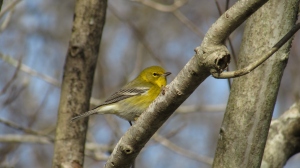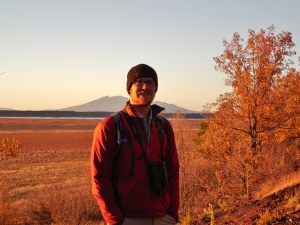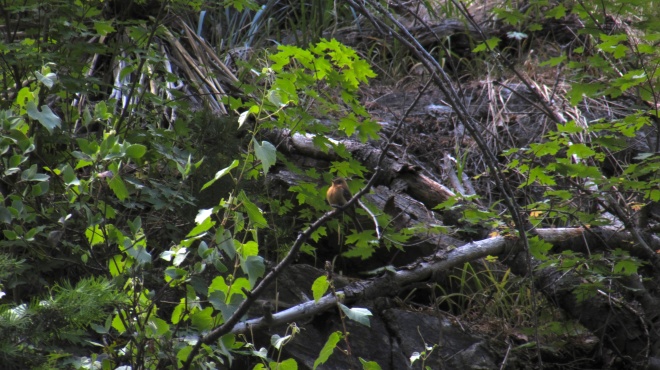I just recently had my first first-author paper accepted for publication in Proceedings of the Royal Society of London Series B! The paper was the result of work I started as an undergrad at Trinity University, where I worked with both Troy Murphy (link) and Michele Johnson (link) on my honors thesis. It is crazy to think that I started this work four years ago. Briefly, we were  testing a novel hypothesis to explain the geographic patterns of sexual differences in coloration in wood-warblers. The geographic pattern is that
testing a novel hypothesis to explain the geographic patterns of sexual differences in coloration in wood-warblers. The geographic pattern is that  as you move north away from the equator, birds (not just wood-warblers) seem to exhibit greater differences in coloration between the sexes (sexual dichromatism). We hypothesized that this pattern was driven by evolutionary increases in the distance species migrated. We thought that longer migration distances would be costly to individuals, which would select against being colorful, which is also costly. However, males gain great benefits by being colorful since they use their coloration to attract
as you move north away from the equator, birds (not just wood-warblers) seem to exhibit greater differences in coloration between the sexes (sexual dichromatism). We hypothesized that this pattern was driven by evolutionary increases in the distance species migrated. We thought that longer migration distances would be costly to individuals, which would select against being colorful, which is also costly. However, males gain great benefits by being colorful since they use their coloration to attract  mates (females do not do this), so we predicted that males would maintain their coloration while females would lose it – thus the observed geographic pattern. Through our work, we found that this hypothesis was indeed supported! Check out the paper here. Excitingly, this paper has been picked up by several science news outlets, such as Science, Nature, and IFL Science. Be sure to check them out as well!
mates (females do not do this), so we predicted that males would maintain their coloration while females would lose it – thus the observed geographic pattern. Through our work, we found that this hypothesis was indeed supported! Check out the paper here. Excitingly, this paper has been picked up by several science news outlets, such as Science, Nature, and IFL Science. Be sure to check them out as well!
Endemic and Rare birds of Southeastern Arizona
Southeastern Arizona is home to a unique geological phenomenon called the sky islands. Basically, there are several isolated mountain ranges throughout SE Arizona. The more notable ranges include the Chiricahua, Huachuca, and Santa Rita mountains. These ranges are also home to many unique birds of the United States that can only be found in SE Arizona. Some of these unique species can be found in SW New Mexico, and certain parts of Texas, as well, such as the varied bunting. Some are quite common here, while others are very rare and are not found every year. Through my travels and work here, I’ve been fortunate to see and even photograph some of the rare and endemic species. Most notable are two particularly rare birds that I saw at the Ramsey Canyon Preserve near Sierra Vista: the flame-colored tanager and tufted flycatcher. Birders from all over the country are traveling to see these two species, who both seem to be nesting in the canyon. Here are some ok pictures of them:
In addition to those species, I was able to find several others, including many lifers for me, such as the elegant trogon, thick-billed kingbird, varied bunting, Arizona woodpecker, magnificent hummingbird, northern beardless-tyrannulet, sulphur-bellied flycatcher, Mexican jay, red-faced warbler, Botteri’s sparrow, Montezuma’s quail, and scaled quail. Here are some pictures of these birds I’ve seen.
Field Update #2 – Sonoita-Patagonia Creek Preserve
In addition to searching for black-chinned hummingbirds at the Audubon Research Ranch, I’m also conducting my work at The Nature Conservancy Sonoita-Patagonia Creek Preserve. While this place is less than an hour drive away, it is fairly different from the ranch. The preserve is a rich and lush riparian area, surround by a mesquite filled semi-arid environment.
You can easily find multiple hummingbird species here, which makes things a bit more complicated, but there are plenty of black-chinned hummingbirds going to the feeders they have established here. I’ve only scouted here a few times, but I’m excited to continue to work here, because the overall bird diversity is great! Last time I went, I saw over 50 species, including a varied bunting and thick-billed kingbird.
Summer 2015 Field Season Update #1
The start of this blog also coincides with the start of my current field season. I am studying black-chinned hummingbirds at the Audubon Appleton-Whittell Research Ranch. I first need to say that this ranch is not open to the public, however if you are interested in visiting please contact the ranch staff (link). With that said, this place is amazing! It is a grassland littered with canyons and riparian areas (the land around running or dried up creeks and streams). Here are some pictures of the land and the different habitats I’m exploring.
I’ve been focusing on the canyons and riparian areas to find my hummingbirds. I usually find males perching on a bare tree top, keeping watch on their territories (left). However, many of the trees these males have been choosing are in some tough to reach spots, like along the ridges of long canyons.  I’ve only found a few males so far, but as I learn the lay of the land and speak to bird experts in the area, I expect to have much more success. In addition to finding hummingbirds, I’m finding so many other animals, including several species of birds, a plethora of deer, many lizards and snakes, and some interesting insects. I’m very excited to continue to explore this area and do my work here as it is such a beautiful place and full of interesting creatures!
I’ve only found a few males so far, but as I learn the lay of the land and speak to bird experts in the area, I expect to have much more success. In addition to finding hummingbirds, I’m finding so many other animals, including several species of birds, a plethora of deer, many lizards and snakes, and some interesting insects. I’m very excited to continue to explore this area and do my work here as it is such a beautiful place and full of interesting creatures!
About me
As I mentioned, I am a Ph.D. student at Arizona State University. I am getting my Ph.D. in animal behavior, and I am finishing up my third year. I have been doing biological research for seven years at this point, as I started doing research my first summer at college (2009). Its been quite a journey for me, that has lead me from cancer research, to ecological modeling, and finally to studying behavior in the field.

I have always loved being outside and exploring the natural world. When I was young, my family traveled a lot, especially in the western half of the US, visiting a plethora of national and state parks. Two of my most memorable experiences were visiting Glacier National Park and a month-long trip we took to drive to Alaska, where I was able to see a huge variety of environments and wildlife. I have also spent considerable amounts of time in the South, such as in some of the beautiful old-growth forests and black-water swamps of South Carolina. As an adult, I continue to explore our natural world, both for fun and for my job! My research has taken me to many places around the world, including Canada, Panama, and Japan. I have worked with a reasonable diversity of animals, though most of my work has been on birds. I have also contacted some work on mice and rats, grasshoppers, and beetles.
 As I am in my 3rd year of my Ph.D., I am in the midst of my work for my dissertation. I am studying hummingbirds, and specifically I am exploring the evolutionary relationships between their colorful plumage and display behaviors during courtship (see here for more information). The vast majority of my work is conducted in the field, which I very much so prefer. I love studying animals in their natural habitats. Through my field work, I not only learn a ton about the organisms I study, but I also learn a lot about the areas I conduct my work in and all the other life that inhabits it. Because I spend day after day for fairly long stretches of time at one field site, I am able to witness some of the rarer animal occurrences. For instance, while at some of my field sites in southern Arizona, I have seen rock and Arizona black rattlesnakes:
As I am in my 3rd year of my Ph.D., I am in the midst of my work for my dissertation. I am studying hummingbirds, and specifically I am exploring the evolutionary relationships between their colorful plumage and display behaviors during courtship (see here for more information). The vast majority of my work is conducted in the field, which I very much so prefer. I love studying animals in their natural habitats. Through my field work, I not only learn a ton about the organisms I study, but I also learn a lot about the areas I conduct my work in and all the other life that inhabits it. Because I spend day after day for fairly long stretches of time at one field site, I am able to witness some of the rarer animal occurrences. For instance, while at some of my field sites in southern Arizona, I have seen rock and Arizona black rattlesnakes:
Outside of my research, I enjoy hiking, camping, and various other outdoor activities, as you will see through this blog. My current goal for the duration of my tenure at ASU, is to visit every wilderness area in the state. There are 90 wilderness areas in Arizona (check them out here), which vary in size and remoteness. So far, I’ve only been two 9 of them, so I have a long way to go! I will make sure to write a post about each one as I visit them, and I will write about the ones I have already visited as well.
Welcome to Thoughts from a Graduate Student, Amateur Naturalist, and Adventurer!

Hello everyone and welcome to my blog! To those who have followed some of my previous blog attempts – welcome back! My name is Rick Simpson, and I am finishing my 3rd year of my Ph.D. at Arizona State University. Through this blog, I plan to share my thoughts, opinions, and stories on a variety of topics, such as life as a graduate student, my travels across Arizona and elsewhere, and my research experiences. I may also write about and discuss cool and interesting papers as they arise. Additionally, because I am interested in colorful and exaggerated visual traits in animals, I will be posting as many pictures and other visual media as possible throughout my posts. Some posts will be long, while others will be short. In some, I might rant about something that bothers me, but I will keep that to a minimum. Ultimately, I hope that this blog will be both entertaining and informative! Finally, please give me feedback as I go, so that I can continue to improve.
















